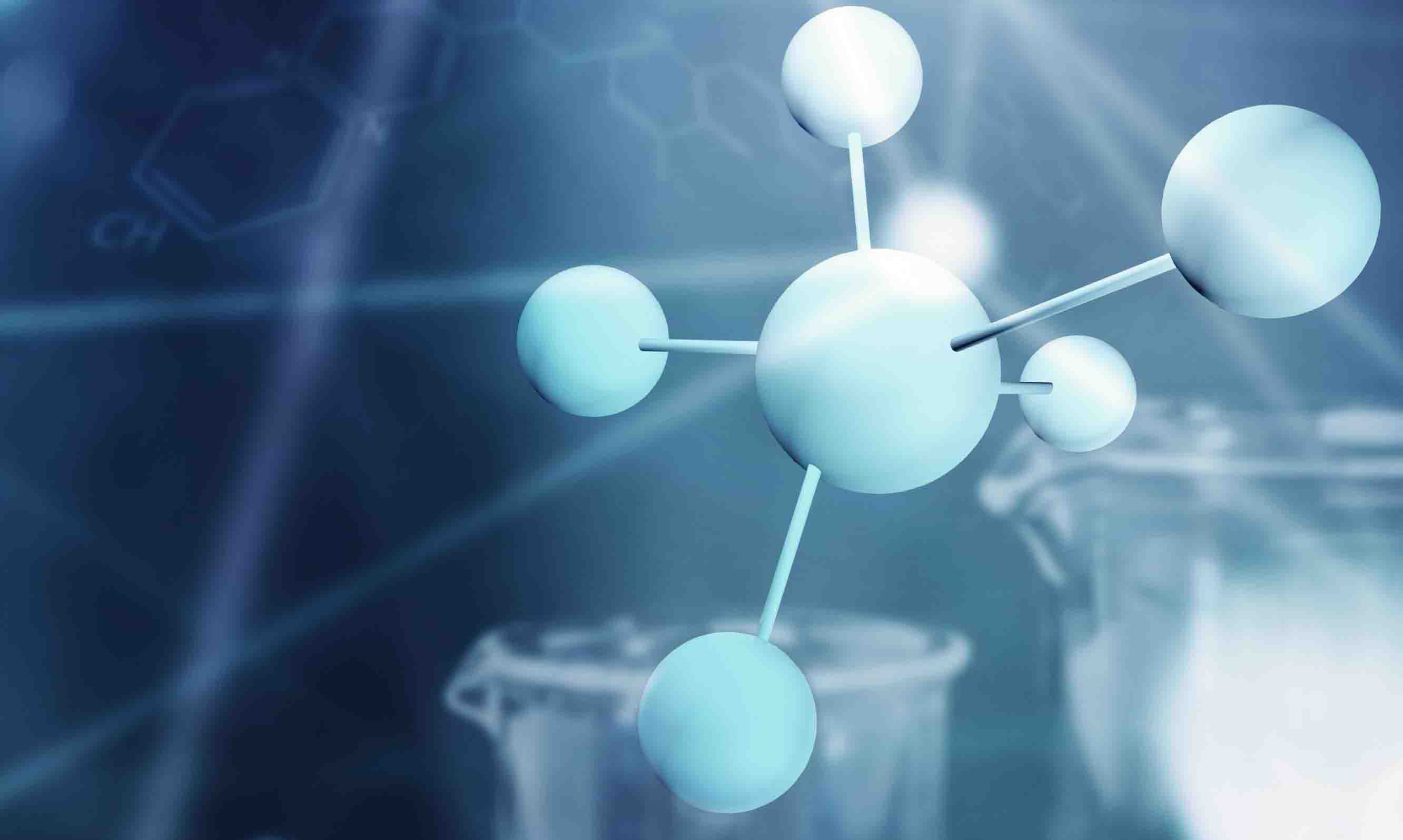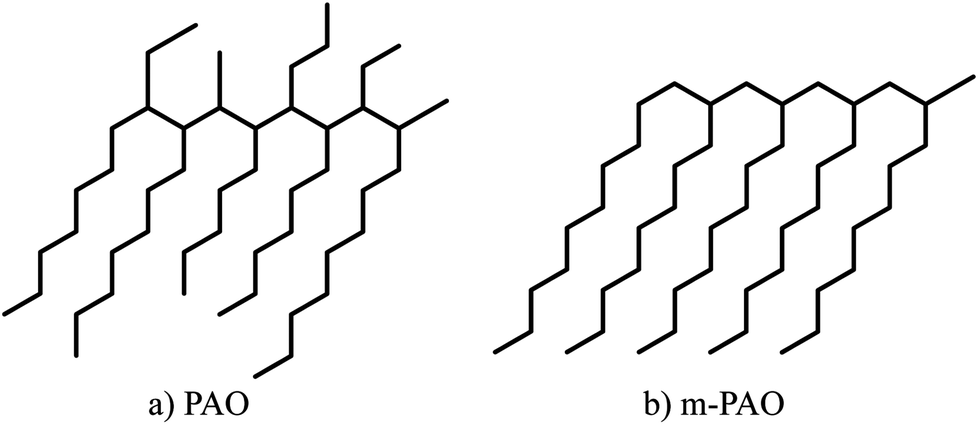Definition and Chemical Structure
Polyalphaolefins (PAOs) are synthetic hydrocarbons produced through the oligomerization of linear alpha-olefins, primarily 1-decene, followed by hydrogenation to create fully saturated molecules with the molecular formula CₙH₂ₙ₊₂. PAOs are classified as API Group IV base oils, representing the most common synthetic base oil used in industrial and automotive lubricants.
Chemical Characteristics
Molecular Structure
PAOs possess a uniform, controlled molecular structure that distinguishes them from mineral oils:
- No ring structures, double bonds, sulfur, nitrogen, or waxy hydrocarbons
- Highly branched, saturated hydrocarbons with predictable molecular weights
- Very non-polar nature resulting from their pure hydrocarbon composition
- Absence of impurities makes them colorless, odorless, non-toxic, and non-corrosive
Molecular Formula and Molecular Weight
The most commonly cited general formula for PAOs is (CH₂CHR)ₙ, where:
- R = alkyl side chain (typically C₈H₁₇ for decene-based PAOs)
- n = degree of oligomerization (usually 2-5 for commercial PAOs)
For 1-decene-based PAOs, the more specific formula is [CH₂CH[(CH₂)₇CH₃]]ₙ, where:
- CH₂CH[(CH₂)₇CH₃] represents the repeating 1-decene unit
- n = number of oligomer units (typically 2-5)
Commercial 1-Decene-based PAOs contain mixtures of different oligomers:
| Oligomer Type |
Formula |
Carbon Count |
Molecular Weight |
| Dimer |
C₂₀H₄₂ |
20 |
282 g/mol |
| Trimer |
C₃₀H₆₂ |
30 |
422 g/mol |
| Tetramer |
C₄₀H₈₂ |
40 |
562 g/mol |
| Pentamer |
C₅₀H₁₀₂ |
50 |
702 g/mol |
Production Process
PAO production begins with ethylene derived from crude oil or natural gas through cracking processes. The process involves several key steps:
- Alpha-olefin synthesis: Ethylene is converted to linear alpha-olefins (primarily 1-decene) through oligomerization
- Catalytic oligomerization: Alpha-olefins undergo polymerization using specialized catalysts forming a mixture of olefin dimers, trimers, tetramers and higher oligomers
- Hydrogenation: Unsaturated oligomers are hydrogenated to achieve full saturation
- Fractionation: Products are distilled to obtain specific viscosity grades
PAO Grades and Classifications
Low Viscosity PAOs (Conventional)
PAOs are classified by their kinematic viscosity at 100°C:
| Grade |
Viscosity
@ 100°C (cSt) |
Viscosity
@ 40°C (cSt) |
Pour Point
(°C) |
Viscosity
Index |
| PAO 2 |
1.7 |
5.1 |
-73 |
130-140 |
| PAO 4 |
3.9 |
16.8 |
-68 |
124 |
| PAO 6 |
5.9 |
30.5 |
-61 |
137 |
| PAO 8 |
7.8 |
46.4 |
-56 |
138 |
| PAO 10 |
9.5 |
60.3 |
-49 |
14 |
Different PAO viscosity grades correspond to different average molecular weights:
| PAO Grade |
Average
Molecular Weight |
Primary Oligomers |
| PAO 2 |
~280-320 g/mol |
Dimers, some trimers |
| PAO 4 |
~400-450 g/mol |
Trimers, some tetramers |
| PAO 6 |
~500-550 g/mol |
Tetramers, some pentamers |
| PAO 8-10 |
~600-700 g/mol |
Higher oligomers |
High Viscosity PAOs
Conventional high-viscosity PAOs as well as Metallocene PAOs (mPAOs) contain higher molecular weight oligomers, with molecular weights ranging from 800-2000+ g/mol, corresponding to hexamers, heptamers, and higher oligomers.Conventional high viscosity grades:
- PAO 40: 39 cSt at 100°C, VI 147
- PAO 100: 100 cSt at 100°C, VI 170
Metallocene PAOs (mPAOs)
Advanced high-viscosity grades with superior properties:
| Grade |
Viscosity
@ 100°C (cSt) |
Viscosity
@ 40°C (cSt) |
Pour Point
(°C) |
Viscosity
Index |
| mPAO 65 |
65 |
605 |
-46 |
178 |
| mPAO 100 |
101 |
1,037 |
-39 |
191 |
| mPAO 150 |
156 |
1,719 |
-36 |
204 |
Ultra-high viscosity mPAOs can reach 600-2000 cSt at 100°C with viscosity indices exceeding 270.
Superior Properties and Advantages
Thermal and Oxidative Performance
PAOs demonstrate exceptional thermal stability:
- Continuous service temperature: Up to 160°C (320°F)
- Intermittent service: Up to 270°C (520°F)
- Superior oxidation resistance compared to mineral oils when properly additivated
- High thermal stability prevents breakdown and extends lubricant life
Temperature-Viscosity Characteristics
Outstanding viscosity-temperature performance:
- High viscosity index (130-200+) maintains viscosity across wide temperature ranges
- Excellent low-temperature fluidity with pour points as low as -73°C
- No wax content ensures best low-temperature performance among synthetics
- Superior Brookfield viscosity for improved cold-start performance
Volatility and Stability
Enhanced volatility characteristics:
- Lower volatility than equiviscous mineral oils (reduced NOACK values)
- Higher flash points improve safety and reduce emissions
- Excellent shear stability maintains viscosity under mechanical stress
- Predictable molecular weights due to controlled synthesis
Applications and Market Uses
Automotive Applications
Extensive use in automotive fluids:
- Engine oils: High-performance motor oils requiring wide temperature operation
- Transmission fluids: Automatic and manual transmission applications
- Gear oils: Differential and axle lubricants for extreme conditions
- Power steering fluids: Applications requiring low-temperature fluidity
Industrial Applications
Broad industrial lubricant uses:
- Hydraulic oils: Systems operating in extreme temperature conditions
- Compressor oils: Rotary screw, reciprocating, and centrifugal compressors
- Bearing oils: High-speed and high-temperature bearing applications
- Turbine oils: Gas and steam turbine lubrication
- Metalworking fluids: Cutting oils and hydraulic fluids
Specialty Applications
High-performance niche applications:
- Aviation lubricants: Jet engine oils and specialty aerospace fluids
- Wind turbine gearbox oils: Long-drain interval applications
- Grease base fluids: Wide temperature range greases
- Food-grade lubricants: NSF-approved applications
- Immersion cooling fluids: High-performance computing applications
Limitations and Challenges
Technical Limitations
Despite superior properties, PAOs have some drawbacks:
- Seal shrinkage tendency: Can cause seal compatibility issues
- Poor additive solubility: Limited solvency for common lubricant additives
- Lower natural lubricity: Requires friction modifier additives for boundary lubrication
- Poor biodegradability: Environmental persistence concerns
Economic Considerations
- Higher cost: Approximately 4 times more expensive than mineral oils
- Compatibility requirements: Often blended with 5-20% ester base oils to overcome limitations
- Reformulation costs: Significant time and expense to modify existing formulations for mPAO technology
References
Base on information gathered from Machinery Lubrication, Chevron Phillips Chemical, Storchem Inc., Connect Chemicals, KCK Lubricants, ÖleZol, LubChem, DeveLub, Lubrex, NLGI, Kemat Belgium, Bohrium, Naco Synthetics, STLE, DowPol, HH Chemical, Kemipex, Wikipedia, PubMed Central, Dupont, Soltex Inc., Super Edge Lubricants. ChemAnalyst.











